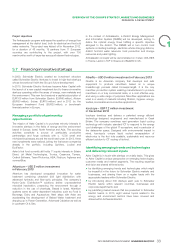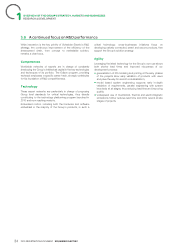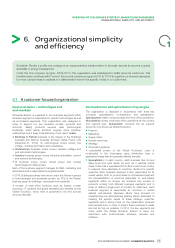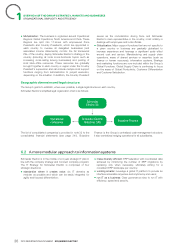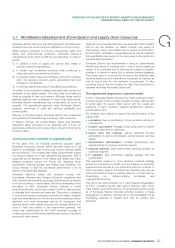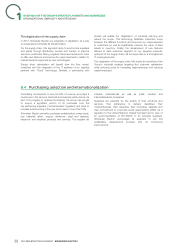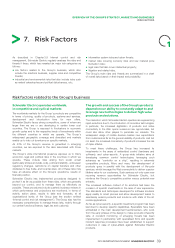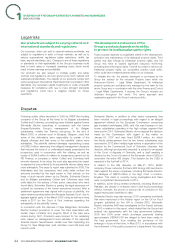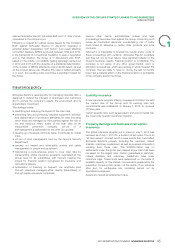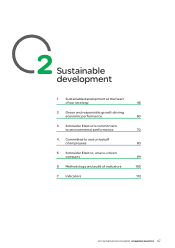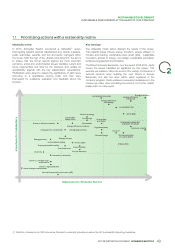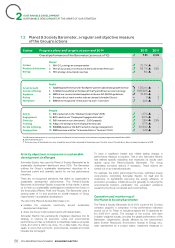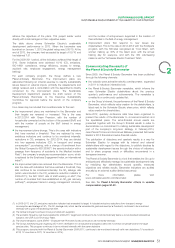APC 2013 Annual Report Download - page 45
Download and view the complete annual report
Please find page 45 of the 2013 APC annual report below. You can navigate through the pages in the report by either clicking on the pages listed below, or by using the keyword search tool below to find specific information within the annual report.
OVERVIEW OF THE GROUP'S STRATEGY, MARKETS AND BUSINESSES
RISK FACTORS
We manage our exposure to currency risk to reduce the sensitivity
of which roughly 57% was for copper. The Group enters into swap
of earnings to changes in exchange rates through hedging
and options agreements intended to hedge all or part of its
1
programs relating to receivables, payables and cash flows, which
non-ferrous and precious metals purchases in order to limit the
are primarily hedged by means of forward purchases and sales.
impact of price volatility of these raw materials on our results. At
December31, 2013, the Group had hedged positions with a
Depending on market conditions, risks in the main currencies may
nominal value of EUR166million on these transactions.
be hedged based on cash flow forecasting using contracts that
expire in 12months or less.
Counterparty risk
Schneider Electric’s currency hedging policy is to protect our
subsidiaries against risks on transactions denominated in a
Financial transactions are entered into with carefully selected
currency other than their functional currency. More than twenty
counterparties. Banking counterparties are chosen according to the
currencies are involved, with the US dollar, Hong Kong dollar,
customary criteria, including the credit rating issued by an
Singapore Dollar, Hungarian Forint and Russian Rubbles
independent rating agency.
representing the most significant sources of those risks. The
financial instruments used to hedge our exposure to fluctuations in Group policy consists of diversifying counterparty risks and
exchange rates are described in note26 to the consolidated periodic controls are performed to check compliance with the
financial statements for the year ended December31, 2013 related rules.
(Chapter5). In addition, the Group takes out substantial credit insurance and
In2013, revenue in foreign currencies amounted to uses other types of guarantees to limit the risk of losses on trade
EUR17.7billion, including around EUR5.4billion in US dollar and accounts receivable.
3.0billion in Chinese yuan.
Liquidity risk
The main exposure of the Group in terms of currency exchange
risk is related to the US dollar, the Chinese yuan and to currencies
Liquidity is provided by the Group’s cash and cash equivalents and
linked to the US dollar. The Group estimates that in the current
undrawn confirmed lines of credit. As of December31, 2013, the
structure of its operations, a 5% increase of the euro compared to
Group had access to cash and cash equivalents totaling
the US dollar would have a negligible impact on operating margin
EUR5,5billion. As of December31, 2013, the Group had EUR
(a translation effect of EUR45million on EBITA).
2,7billion in undrawn confirmed lines of credit, of which
Equity risk
EUR2.7billion matures after December2015.
The Group’s credit rating enables it to raise significant long-term
financing and attract a diverse investor base. The Group currently
Exposure to equity risk primarily relates to treasury shares but
has an A- (negative outlook) credit rating from Standard&Poor’s
remains limited. The Group does not use any financial instruments
and an A3 credit rating from Moody’s. The Group’s liabilities and
to hedge thesepositions.
their terms and conditions are described in note24 of Chapter5.
An increase in raw material prices could have
In line with the Group’s overall policy of conservatively managing
liquidity risk and protecting our financial position, when negotiating
negative consequences
new liquidity facilities the Group avoids the inclusion of clauses that
would have the effect of restricting the availability of credit lines,
The Group is exposed to fluctuations in energy and raw material such as covenants requiring compliance with certain financial ratios.
prices, in particular steel, copper, aluminum, silver, lead, nickel, zinc As of December31, 2013, Schneider ElectricSA had no financing
and plastics. If we are not able to hedge, compensate for or pass on or confirmed lines of credit that were subject to covenants requiring
to customers any such increased costs, this could have an adverse compliance with financial ratios.
impact on our financial results.
The loan agreements or lines of credit for some of our liquidity
The Group has, however, implemented certain procedures to limit facilities include cross-default clauses. If we were to default on any
exposure to rising non-ferrous and precious raw material prices. The of our liquidity facilities, we could be required to repay the sums due
purchasing departments of the operating units report their on some of these facilities.
purchasing forecasts to the Corporate Finance and Treasury
Moreover, anticipated reimbursement provisions exist for certain
Department. Purchase commitments are hedged using forward
financing and lines of credit in case of change of control. Under
contracts, swaps and, to a lesser extent, options.
these provisions, the debt holders may demand repayment if a
The financial instruments used to hedge our exposure to fluctuations shareholder or shareholders acting together hold more than 50% of
in raw material prices are described in note26 to the consolidated the company’s shares, for the majority of contracts, and this event
financial statements for the year ended December31, 2013. triggers a downgrading of the company’s rating. As of
In2013, purchases of raw materials totaled around EUR2billion, December31, 2013, EUR5.5billion of the Group’s financing and
including around EUR1billion for non-ferrous and precious metals, lines of credit had these types of provisions.
43
2013 REGISTRATION DOCUMENT SCHNEIDER ELECTRIC


